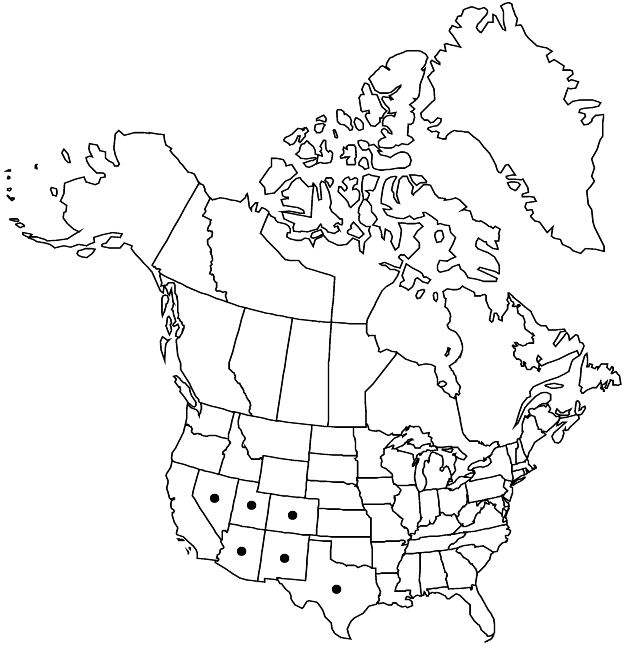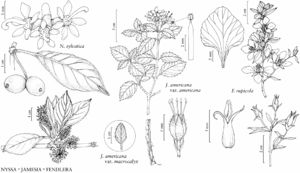Fendlera rupicola
Smithsonian Contr. Knowl. 3(5): 77, plate 5. 1852.
Stems 5–30 dm. Branches never becoming thorn-tipped; twigs sericeous-strigose, trichomes appressed, loosely appressed, and/or minute and branched, glabrescent. Leaves: blade usually elliptic, lanceolate, oblong, ovate, or falcate, rarely linear, 10–38 × 2–10 mm, herbaceous to coriaceous, base cuneate to rounded, margins plane or slightly to strongly revolute, not touching midvein, apex obtuse, acute, or slightly attenuate, abaxial surface visible, sericeous-strigose, trichomes often coarse, 0.2–0.6 mm, sometimes also with understory of minute, branched trichomes, adaxial surface glabrous or sparsely to moderately sericeous-strigose, trichomes ± appressed, 0.2–0.6 mm, and/or hispidulous, trichomes erect, 0.1–0.2 mm; midvein 0.2–0.3 mm wide, raised. Pedicels 1–25 mm, glabrous or sparsely sericeous-strigose, trichomes ± appressed, and/or with minute, branched hairs. Flowers: hypanthium and calyx-tube 2–3 mm; sepals erect or reflexed, narrowly to broadly triangular, 4–8.5 × 1.5–4 mm, sparsely to moderately sericeous-strigose and/or with minute, branched trichomes abaxially; petals white or tinged pink or red, 8–15 × 5–14 mm, claw 3–4 mm, blade usually ovate or ovate-rhombic, rarely oblanceolate, obovate, or oval, margins erose; filaments 3–8 × 1–2.5 mm; anthers 2–3.5 mm; styles 4.5–6 mm. Capsules ovoid to ellipsoid, 7–15 × 5–8 mm. Seeds 5–8 mm.
Phenology: Flowering Apr–Jun (Aug–Oct).
Habitat: Limestone bluffs and ledges, sandstone hillsides, granitic soils, rocky and brushy slopes, among boulders, desert grasslands, chaparral, oak and juniper-oak woodlands.
Elevation: 700–2800 m.
Distribution

Ariz., Colo., Nev., N.Mex., Tex., Utah, Mexico (Chihuahua), Mexico (Coahuila), Mexico (Sonora)
Discussion
B. L. Turner (2001) divided Fendlera rupicola into three species. He restricted F. rupicola to plants from central Texas with large, thin leaf blades with flat margins and sparse vestiture and contrasted those with plants from more arid areas farther west with leaf blades that are smaller, more often coriaceous, and revolute margined, with the surfaces sparsely to densely strigose, sometimes also hirtellous adaxially. Turner assigned these more western plants to two species. The first, F. wrightii, has abaxial leaf blade surfaces with an overstory of coarse, appressed to ascending trichomes and an understory of minute, branched trichomes; the adaxial surface is strigose and hispidulous, especially near the margins. According to Turner, this species occurs from trans-Pecos Texas west to Arizona and southeastern Nevada, north to extreme southern Colorado, and south to Chihuahua and Sonora, Mexico. The second western species, F. falcata, has similar leaves, but the abaxial surfaces lack the understory of minute, branched trichomes, and sometimes they are glabrous or only strigose adaxially. Maps provided by Turner show the distribution of F. falcata broadly overlapping that of F. wrightii but extending farther north in Colorado and into southeastern Utah. Despite this extensive sympatry, Turner reported that the two species rarely occur together, stating that in trans-Pecos Texas and southeastern New Mexico, for example, F. falcata occurred at higher elevations and on igneous substrates, whereas F. wrightii occurred at lower elevations on limestone substrates. Turner did not examine populations from elsewhere and considered many of the Sonoran specimens he examined, in addition to some from northern Arizona, to be intermediate between F. falcata and F. wrightii.
In contrast to the treatment by B. L. Turner (2001), N. H. Holmgren and P. K. Holmgren (1997) considered size, shape, and vestiture of leaves to be too variable to warrant recognition of infraspecific taxa in Fendlera rupicola. Their conclusion is supported by examination of numerous specimens and study of some populations (J. Henrickson, pers. obs.). The density of branched trichomes on the abaxial leaf blade surfaces varies from fairly dense to sparse, and even leaves that appear to have no branched trichomes are sometimes found to have them next to the midvein when examined with SEM. Despite some correlation between the presence or absence of the branched understory trichomes and blade thickness, the development of revolute margins, and the density of adaxial vestiture, variation in all these characters is essentially continuous. Furthermore, populations containing both plants with and without branched understory trichomes are more common than Turner reported, and the alleged difference between F. falcata and F. wrightii in substrate preference does not hold, even in Texas. Plants agreeing with Turner's concept of F. rupicola, which he considered to be restricted to Texas, occur in New Mexico west to the Grand Canyon area of Arizona, and some specimens from shaded habitats in Arizona are nearly identical to the type of F. rupicola. Consequently, a broad concept of F. rupicola is adopted here.
Fendlera rupicola is reportedly a favorite browse of deer, goats, sheep, and cattle. D. E. Moerman (1998) reported that early Native Americans used plants for drugs and as ceremonial items, and the hard wood for making arrow shafts. Vegetatively, some plants of Fendlera rupicola are nearly impossible to distinguish from similar forms of Philadelphus microphyllus.
Selected References
None.
Lower Taxa
"dm" is not declared as a valid unit of measurement for this property."connate" is not a number. "distinct" is not a number.
